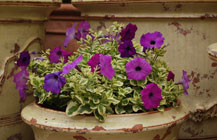4/25/2013
Putting the Glam in Petunias
Jessica DeGraaf

When most people see Glamouflage Grape Petunia for the first time their response is usually, “Wow!” This new petunia offers striking grape-colored flowers that are accented by eye-catching variegated leaves. Grown more for its foliage characteristic than for its flowers, Glamouflage Grape is spectacular in monoculture pots or as an accent in mixed containers. Very heat tolerant, Glamouflage Grape has a very thick, waxy leaf reminiscent of a succulent.
Finished height and spread 6 to 8 in. (15 to 20 cm); 10 to 16 in. (25 to 40 cm)
Media and pH Glamouflage Grape requires a well-drained, soilless media with a pH of 6.0 to 6.3 and an EC level of less than 1.5 (using a 1:2 extraction method). Ensure that the newly transplanted liner is even with the media level of the new container. This will reduce the potential for wilt and stress to occur on the new liner. Liners should be kept moist upon transplant, but they should not be oversaturated. Once liners have sufficiently rooted out, begin to allow the media to dry down between irrigations.
Temperature and daylength To promote optimum growth, provide high light levels, moderate to cool temperatures and negative DIF. Maintain day temperatures of 60 to 70F (15 to 21C) and night temperatures of 55 to 65F (12 to 18C). Flowering is directly related to temperature and daylength. Petunia Glamouflage Grape will take longer to flower when grown under cooler temperatures and short-day conditions. Glamouflage Grape responds extremely well to high light levels. Maintain light levels of 5,000 foot candles to promote best growth and flowering, while maintaining moderate temperature levels. Note that temperatures greater than 75F (23C) can cause stretching. Under short-day (SD) conditions in early spring, the use of night break lighting from 10:00 p.m. to 2:00 a.m. is beneficial and reduces time to flower.
Fertilizer Provide a moderate amount of fertilizer. A constant application of a balanced ammonium and nitrate-based form fertilizer with low phosphorous promotes optimum growth. Rates of 175 to 225 ppm are most effective and produce good growth and lush foliage. Maintain pH levels of 5.5 to 6.0. If pH rises above 6.0, iron uptake is reduced, causing the plant to show interveinal chlorosis on new growth. To combat this issue, apply EDDHA Iron to fertilizer applications as needed.
Growth regulation Glamouflage Grape is naturally compact. It requires very little pinching and doesn’t require PGR application. A pinch may be applied 7 to 10 days after transplant to promote basal branching.
Pests and diseases Maintaining good cultural and IPM practices throughout the production of Glamouflage Grape will greatly decrease the incidence of the following pests and diseases: aphids, whiteflies, fungus gnats, thrips, Botrytis, Pythium, Rhizoctonia, Phytophthora and powdery mildew. A preventative application of a fungicide to prevent powdery mildew is strongly recommended.
Crop timing As Glamouflage Grape does have variegated foliage and, therefore, less chlorophyll, it’s a slower-growing variety than other Petunia grandiflora varieties.
Quart pot: 9 to 10 weeks (early spring); 8 to 9 (spring-summer)
6-in. pot: 10 to 12 weeks (early spring); 10 to 11 weeks (spring-summer)
12-in. hanging basket (5 plants per pot): 14 to 16 weeks (early spring); 14 to 15 weeks (spring-summer)
GT
Jessica DeGraaf is Program Coordinator for Hort Couture. For more information on where to purchase Glamouflage Grape Petunia, visit www.hortcoutureplants.com.